Mongolia Notebooks
Notes from a second year in Mongolia, this time in Ulaanbaatar, its capital and largest city. Articles revolve, sometimes in a wide orbit, around the collision of cultures taking place as a rural nomadic population becomes increasingly urban, technological, and western. Newest entries are on top. The title and first picture in each article link to more images and the rest of each story.
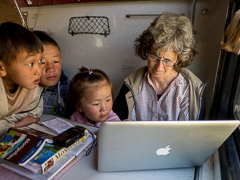
Mongolia, Again ~ 2014-07-14
Sometime in the fall, the seed for another trip abroad found its way to our table. The application deadline for the English Language Fellow program was coming up in January, and Judy and I needed to make a decision on what our next move would be. Her job in Missoula would last until the end of August. Most of my belongings were in a storage unit. Having resisted the urge for pets, we had no animals to be concerned about. We were living in an apartment with a month-to-month lease. Even though it felt like I was just getting settled, if there was ever a time to spend another year in a foreign country, this would be one of the easiest. more...
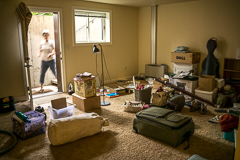
Waiting ~ 2014-09-18
Once Judy was accepted, our time in Missoula suddenly seemed short. Our imagined departure date was somewhere between September 1–15. We gave notice to our landlord. We began shifting unused items into boxes, sold them on ebay, (Judy) or dumped them into the trash (me). Part of every day was spent distilling things down so that when the call came, we would each be able to close two suitcases on everything we would need for the coming year. more...
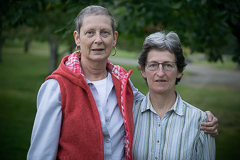
Send Off ~ 2014-10-19
When the call finally came asking Judy to confirm our flights for Friday morning at 5:45am, it was already Tuesday afternoon. That left Wednesday and Thursday to wrap up everything and close our bags. We listened to those who helpfully pointed out that we should have been ready to go, since we had so much time to prepare. But having packed and unpacked so many times, and living out of the same suitcase that I was trying to pack meant that I only imagined that I had everything organized and ready to go. Packing clothes for four seasons was only a small part of our problem. more...
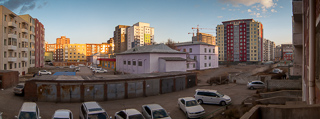
Landing ~ 2014-10-22
Heading west from Kalispell at 5:45am, it was still dark when we landed in Seattle. With pauses for layovers there and in Seoul, we followed the sun for another twenty six hours before landing in Ulaanbaatar at 10:30pm. For us it was one very long day, but because we had crossed the dateline, it was actually a shortened two-day flight. Either way, we were barely conscious for the final leg from Seoul. more...
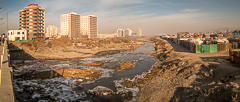
On The Ground ~ 2014-10-28
Our first few days here have taken some adjustment. A little more than a week ago we were living in rural Montana, where people spoke English, and where, when we woke up in the morning, we could usually say with some confidence what we would do that day. more...
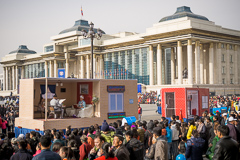
Happy Birthday, Ulaanbaatar ~ 2014-10-29
Today is Ulaanbaatar's 375th birthday. I learned this on my way back from buying more gigas from Skytel this morning. (I ran out the night before on the verge of posting these, my first notebooks.) On my way home I saw fire engines and police everywhere, along with military officers in full dress uniform. I wandered down Peace Avenue to take a look, and what I found were children practicing dance routines, fire engines decorated with balloons, and Sukhbaatar Square filled with festival tents and people. more...
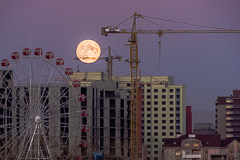
Building ~ 2014-11-13
From above, Ulaanbaatar sprawls east and west, up and down the Tuul River valley between dry grass-covered hills to the north and south. It presents itself as a nearly solid expanse of buildings, broken only occasionally by an open space—a park, vacant lots, or a pending construction site. At street level, you get an entirely different impression. Even without your sense of sight, the sound of construction is everywhere. Jackhammers, drills, grinders, saws, and earthmoving equipment fill the air with their combined roar. A walk around any block with your eyes open will confirm what your ears are telling you. Construction is everywhere, with cranes that loom over the hundreds of partially completed buildings. more...
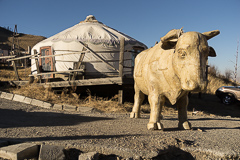
Exploring the Edges ~ 2014-11-15
For nearly two weeks I've been waiting to hear whether I'll get a job at the Mongolian State University of Arts and Culture. Everything now hinges on the Department of Labor, an agency that, under the current economic difficulties, is without motivation to be generous to foreigners. Their approval is needed for the Department of Immigration to grant me a work visa, which I need both to work and to stay in the country for more than ninety days at a stretch. Among several things the university has asked me to do is to photograph and write for their English language website, teach photography to students, and teach English to teachers. A visa will not be issued unless I am providing a significant amount of service to the university, so my schedule looks much more full than I would like it to be. Now, I'm in a bit of a panic to see as much as I can before work pulls me inside. more...
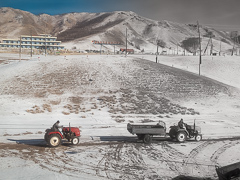
Time-Travel Train ~ 2014-11-24
After spending a month in Ulaanbaatar we traveled to Darkhan this weekend, for Judy to present a workshop at a branch of her university there. We went by train, which for a photographer is both blessing and curse. It was a relief to get out of town and see the landscape to the north of the city, but lashed to the tracks as you are when traveling by rail you can only dream about a chance to come back with more time to spend. The last time we came to Darkhan the temperature was warm enough to travel with the windows open, so that it was possible to make quick snapshots without obstruction. A dozen degrees below freezing in a full car, that was not even a remote option, so what I saw I viewed through filthy glass, three layers thick. more...
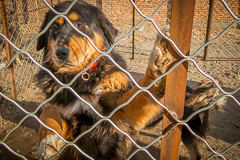
Mongol Bankhar ~ 2014-12-06
As social change influences various parts of the ecological system here, environmental activity can take on unfamiliar twists and turns. Certainly there are examples of activity where one action leads directly to an intended result. A program that encourages ger residents to replace low-efficiency stoves with high-efficiency stoves should yield the intended result of less air pollution. Providing a paved road between two points should prevent soil erosion by offering drivers a good alternative to driving randomly through the desert. more...
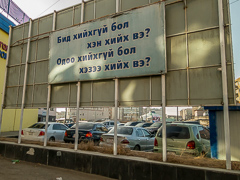
Signs ~ 2014-12-07
In my effort to learn Mongolian, I sometimes take visual notes home to work on at my desk, with dictionary in hand. For a week now I have been working on this sign, with no solution in sight except to ask a Mongolian who also speaks English. The words seem simple enough. The first sentence asks, "We (not (1. air, 2. without purpose, 3. do, make)) (be, become, get) who (1. air, 2. without purpose, 3. do, make)?" more...
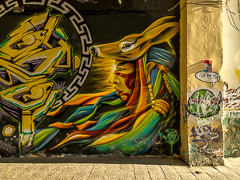
Mongolian Graffiti ~ 2014-12-17
Here is a selection of paintings found on various walls and buildings. They vary from illicit scribbles to sanctioned public art projects, some even part of internationally attended street art festivals, so strictly speaking many of these images go way beyond graffiti. Still, in the medium's origins and in its current practice, there is an attempt by its creators for it to be seen as renegade art, as it is in urban areas around the world. more...
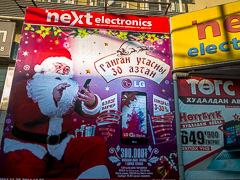
Buddhist Christmas ~ 2015-01-03
Since the middle of November, almost every time I have made an observation about Christmas, Judy has corrected me by saying New Year, in an effort to straighten out my thinking about what happens at this time of year in a country that is mostly Buddhist. It's a hard habit to break. A month and a half before Christmas New Year people start putting up Christmas New Year's trees and decorating them with Christmas New Year's ornaments. Stores and their accompanying advertisements have been hounding Christmas New Year's shoppers. Although Christmas New Year's sales started early, enticing many shoppers to get a jump on their Christmas New Year's shopping, invariably many wait until the last minute, just like in the United States. But by New Year's Eve, it is too late, and most stores and many restaurants settle into one or more days of well-deserved holiday.
more...
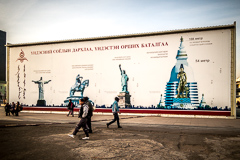
Eco City ~ 2015-01-08
Planted on a road cut that skirts the west-north-west edge of town are the words Eco City, which I walked past several times before my curiosity caused me to look them up, and connect several unconnected and mysterious dots. Mongolia's Maidar Eco City is a new project which combines what surely has to be the world's biggest stuppa and Buddha with a totally green planned city, complete with bike paths and walkways, planned parking, an arterial street system, and lots and lots of greenery. At an office in the Ganan Tegchinlen Monastery you can become a donor to help get the Stuppa + Buddha parts of the project off the ground. A sign outside (and also in Sukhbaatar Square) compares the size of the Buddha and Stuppa to several of the world's well known monuments, including the Statue of Liberty, which they will dwarf. more...
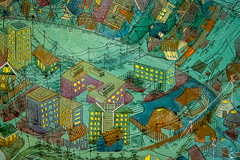
Universe: T. Nurmaajav ~ 2015-01-23
I was invited to the opening of painter T. Nurmaajav's show by her fellow Uvs aimag natives, our former neighbor Tsagana, and her father Norov. I had never been to a Mongolian opening, and this one would be at the Mongolian Modern Art Gallery, a very different venue than the history museums we have seen, such as the Zanizabar Museum. more...
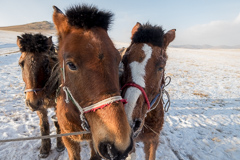
Interlude, by Horse ~ 2015-01-23
As I wait for my work visa issues to be resolved, luck has given me a landlord who runs a guest house, speaks English with a Texas accent, and is in the process of improving the web site for his guest house. Having seen a copy of Learning Mongolia, he asked if I could help him. Before we began, he wanted to make sure he could afford me, and that I would be up for the task. He explained that to understand and write about Mongolia, I would have to see more of it than I had seen. I would need to ride a horse. And a camel. I would need to travel to the Gobi, both in the winter and the summer. I would need to see Khovsgul Noor, Mongolia's biggest lake. I would need to see the most beautiful parts of Mongolia and I would also need to tour the poorest of Ulaanbaatar's ger districts. Hmm, I thought. Someone has to do it. more...
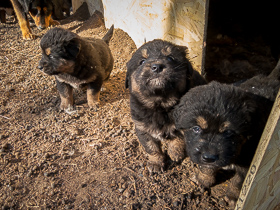
Nomadic Guardians Update ~ 2015-01-24
Here's some news from the headquarters of Nomadic Guardians, which I wrote about a couple of months ago. In addition to the fact that Doug now has an assistant to help with the job of taking care of the growing responsibilities of the operation, three of the Mongol Bankhars have given birth to pups, adding significantly to the canine population there. But that is only half of the story. more...
A mid-winter trip to Thailand has left me with a group of several quick notebooks from the week of exploring I had a chance to do there. Although it is the cool season in Thailand, there was still more than 110°F difference between home in Ulaanbaatar and the sweltering streets of Bangkok. But temperature was not the only difference, or even the biggest. What I found in Thailand deserves its own mini section… more...
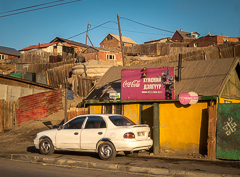
Coca-Cola ~ 2015-02-08
For years, a huge neon Coca-Cola sign faced Sukhbaatar Square from the southwest corner, hanging from the tower of the Mongol Telecom building. Then, in early 2013, it was gone. A large banner-style billboard covers up the stain left on the side of the building, a perfect outline of that very recognizable bottle. I wondered at the time whether Mongolia had had its fill of this very American brand. more...
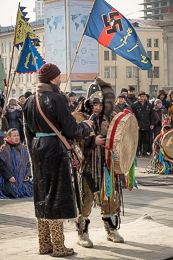
Wired for Protest ~ 2015-02-11
A chance trip to Sukhbaatar Square this morning, for what I thought was one photograph needed for another notebook. Instead, I came upon a protest against mining gold on a mountain considered to be sacred in Mongolia. Initially I thought that this was an environmental protest, but as the morning unfolded, I became less certain about what I was seeing—about any part of what I was seeing. more...
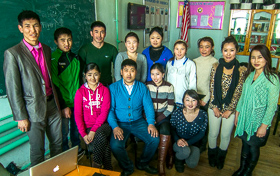
M, Monoxide ~ 2015-02-12
A call from Gulnar this afternoon, to say that one of her classmates—one of my students from Khovd—had died. I was not sure I heard her correctly, hoped that I had not heard her correctly, but eventually came to understand that my former student, his brother, and their father had become victims of burning too much coal with too little ventilation. In Mongolia one does not say the name of the dead, so this is a notebook about someone who might otherwise remain anonymous, except in the memories of his friends and relatives. more...
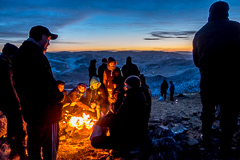
First Light, Tsagaan Sar ~ 2015-02-19
Although it didn't feel like it on this particular morning, the end of winter is in sight with the arrival of Tsagaan Sar, Mongolians' White Month, the largest celebration of the year here. In the coming days, Mongolians will visit relatives and friends and they will also host them, sometimes feeding more than a hundred guests with large quantities of buuz, rice, dairy products, and a wide variety of other food. They will also provide their guests with a going-away present, just as they will receive a small gift from each guest who visits. more...
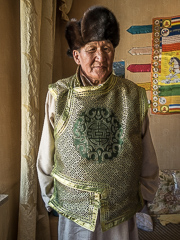
Tsend Ayuush's Father's Brother
Tsagaan Sar ~ 2015-03-10
This year Tsagaan Sar, or White Month, began on the 19th of February. It is the largest traditional family celebration of the year, a fact that we have been reminded of by the hectic pace of shopping over the weeks that lead up to it. Stores have been packed with customers, buying food, buying serving dishes of silver or gold, buying the many small presents that are given to hosts on arrival and to guests, as the universal signal that it is time to leave—to make room for the next scheduled visitors. Tents have been set up in Sukhbaatar Square, below our apartment near the State Department Store, and in other open spaces outside, where vendors are selling dairy products—white or nearly white milk, aruul, aarts, areg, tareg—along with large pieces of meat. (A whole sheep, skinned, and in this weather, frozen solid, sells for around 280,000 tugrigs, or $140 USD. Throughout the city, men are carrying them on their shoulders, sometimes wrapped in a wheat or potato bag, and sometimes without.) more...
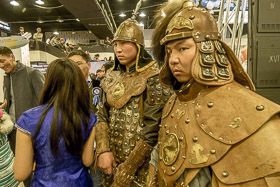
Tourism Trade Show ~ 2015-03-24
When my friend Anand, who is a part owner of Zaya's Guest House, asked me if I'd like to go to a Mongolian tourism trade show, I choked down my first response (sorry, I'm busy) in recognition of the fact that this, like everything else here, would be different than any other trade show I have ever attended. more...
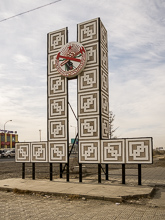
Monuments ~ 2015-04-19
Monuments are built to commemorate people, things, or events that are important to some part of society when they are built. Throughout this country, monuments have been built even in the smallest of towns. In Ulaanbaatar you can't travel far without bumping into one, a marker large or small, dedicated to a piece of Mongolia's history. In this country, history can be fickle, so just having a monument built in your honor does not ensure continued importance or favor. Nor does it mean that you will always have a monument, or that your monument will be always be found, much less cared for. more...
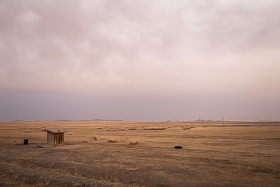
The Eastern Aimags ~ 2015-04-22
Living in Ulaanbaatar it is easy to ignore what it's like to live in Mongolia. In this city of nearly two million, we have an apartment with hot and cold water, plenty of heat in the winter, and with only a short walk, we have been able to get fresh green vegetables straight through the winter. If I could read the Russian, Chinese, and Korean labels, I'm pretty sure I could find practically anything I want here. As it is, we are not wanting for much. more...
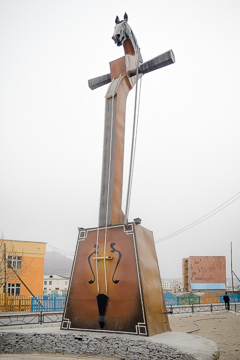
Khovd Again ~ 2015-05-02
It was a peculiar sensation landing in Khovd, stepping off the plane to a place where we lived, for almost a year, on our first visit to Mongolia. Even from the air descending through our approach, the land felt familiar in a way that it really shouldn't. This is not my country, and there are any number of visible reminders of that fact, even from several thousand feet in the air. Yet for the ten months that we lived here I made it my business to learn this land, to find out about the people who lived here, and to see it closely. Surely that investment counts for something. more...
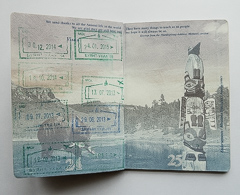
Six Hours in Seoul (No Green Card) ~ 2015-05-03
Two days ago I was asked to fill out an Arrival Card for entry into South Korea. On that card is a section that asks you to explain the purpose of your visit, offering several choices to select by checking a box. After staring at the form for a long time, I finally checked the box next to "Other." Of course it is a longer story than that, though my stay would last for just a few hours. more...
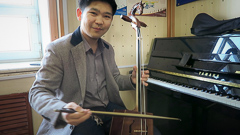
Have you thought about learning to play a bowed, stringed instrument lately? How about one that is both fretless and whose strings are not pressed against a fingerboard, but lightly touched with the tops of the first and second fingers, and just the tips of the third and fourth. Most of the time you get to the high (right) string by reaching over the low, but sometimes, with your pinky, you must sneak underneath. Would you rather bang your head against a concrete floor or poke yourself in the eye with a stick? (I have recently tried one of these.) Learning this instrument seems better than these two other choices right now, but then I'm just getting started. more...
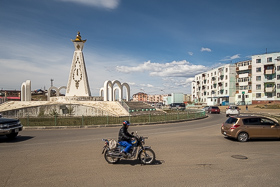
Erdenet Red Eye ~ 2015-05-21
The best advice for traveling in Mongolia is to allow plenty of time, both because there is a lot to see, and because it is common to run into delays. So it was against our better judgement to squeeze in a trip to Erdenet for Judy's teacher training workshop a few days before I needed to be back for another week-long trip. What would make it possible is an overnight train from Ulaanbaatar to Erdenet, which in theory would allow us to travel while we were sleeping, arrive in time for Judy to present a workshop for teachers there, and return the way we came, leaving in the evening and arriving back in Ulaanbaatar the next morning, with the day left for me to get ready for the next trip. A second piece of advice that we broke on this trip is to avoid traveling at night, since you can't see what you are traveling through. more...
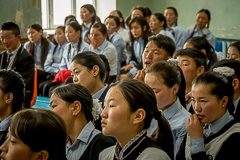
Scholarship Outreach ~ 2015-06-03
Among the diplomatic successes that the United States has had around the world is the Fulbright Program, the purpose of which is the 'promotion of international good will through the exchange of students in the fields of education, culture, and science.' more...
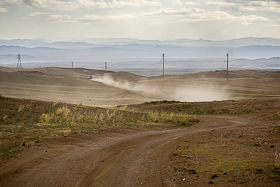
Driving in Central Mongolia ~ 2015-06-10
For the past few weeks I have been seeing Mongolia by mashiin, on journeys for various purposes. The first of these trips was with staff of the US Embassy (see below) in Mongolia, helping to encourage Mongolian secondary school students to work on their English language skills to take advantage of scholarship opportunities in the US. Making a wide loop around the central part of the country, we traveled through parts of Uvurkhangai, Bayankhongor, Govi-Altai, Zavkhan, Arkhangai, and Khovsgol aimags. more...
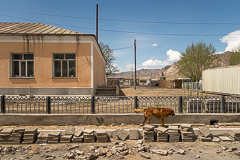
Central Aimag Cities ~ 2015-06-12
In addition to the students we met on the outreach tour and the roads we traveled getting to them, we stopped in some of the larger towns in the region—the aimag capitals of Uvurkhangai, Bayankhongor, Gobi-Altai, Zavkhan, and Arkhangai—as well as some smaller ones that require a good map to find. Most were new territory for me, though by now they seem familiar in a way that they wouldn't have two years ago. Most Mongolian towns of any size have a few common features.
more...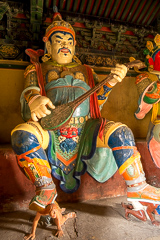
Amarbayasgalant ~ 2015-06-15
Although it had been sunny for most of the day, by the time we got part way down the seventy-five kilometer dirt road to Amarbayasgalant it was raining, dampening the dust we had been plowing through, to give us a better view. Five of us (Judy's sister Nancy and brother-in-law Steve, and my sister Jan) along with our driver Lkhagva (who invited us to call him Toggie) were heading to the tiny village that surrounds the one of the largest Buddhist temples in Mongolia, and one of only several that were not completely demolished in the Stalinist purges of the late 1930s. more...
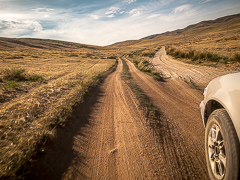
Khustai ~ 2015-12-01
In 1969 the last Takhi, a species of wild horse native to Mongolia, disappeared from the steppe here. As in other areas of their native Central Asia, the species became extinct—except for a few specimens that had been captured by a European visitor and taken to zoos there sixty years earlier. There they became known as Przewalski's Horse, after one of the first European explorers to document them. Takhi cannot be ridden or handled like domestic horses. Although they can breed with domestic horses, they have two extra chromosomes and the result is neither exactly Takhi or domestic horse. more...
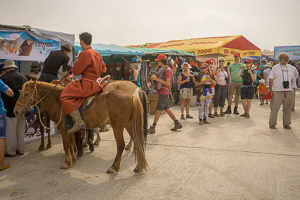
Naadam ~ 2016-01-12
In Ulaanbaatar, Naadam is the biggest public event of the year. Traditionally it is a celebration of the "three manly sports"—archery, wrestling, and horse racing—but it also includes ankle bone shooting, which you might compare to marbles, played while standing, with parts of a sheep's skeleton flicked from a small trough, instead of using glass spheres shot from the ground. While ankle bone shooting may not seem particularly manly, horses are raced by small boys and the open-chested costumes worn for wrestling came about in an effort to prevent a repeat of the historical embarrassment of having a woman wrestling champion. more...


